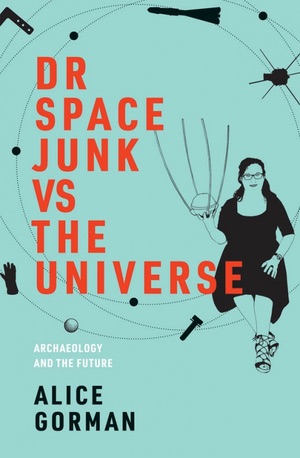Review: Dr Space Junk vs The Universeby Jeff Foust
|
| “Not all space junk was created equal; some bits are clearly more significant than others.” |
Yet, what’s one person’s space junk is another person’s space treasure—or, at least, intellectual curiosity. Alice Gorman is well aware of the threats posed by space debris and the risk of a runway Kessler Syndrome, and the need to be better stewards of the orbital environment. But, as she writes in her new book, Dr Space Junk vs The Universe: Archaeology and the Future, “Not all space junk was created equal; some bits are clearly more significant than others.” Any cleanup effort should consider historic satellites and leave them behind in orbit, she argues. After all, such a system would leave behind operational satellites, “so it’s a small leap to ensure precious artefacts are also preserved in their natural setting.”
Gorman, a senior lecturer at Flinders University in Australia, is one of the leaders of the emerging field of space archaeology, which seeks to apply the techniques and mindset of archaeology to the space field. (It should not be confused with “archaeology from space,” which uses satellite data to assist more traditional terrestrial archaeology.) In her book, Gorman, aka “Dr. Space Junk,” discusses how her career shifted from doing archaeology primarily as part of environmental assessments for Australian construction projects to archaeology of orbital debris and other human imprints onto the cosmos.
That space archaeology can begin on Earth. In one chapter, Gorman discusses how archaeology can provide insights on terrestrial locations related to space, from sites of former tracking stations to space-themed “rocket park” playgrounds that sprung up in the early Space Age. From there, she examines the satellites and debris in Earth orbit, spacecraft left behind on the Moon, and those now speeding into interstellar space.
A key issue is one of preservation: how to protect those old satellites and other artifacts? As noted above, for Earth orbit she proposes protecting valuable defunct spacecraft from any cleanup efforts. But what’s a valuable, or even defunct, spacecraft? “Isn’t representing the cultural heritage of a nation or a community, and making people feel involved in space, useful?” she asks. “If we acknowledge this, then many of the old defunct satellites have a very important function indeed.”
| Space junk can be a hazard, but it can also be a treasure trove. |
On the Moon, there are fewer objects, and in stationary locations, but protecting those artifacts is still complicated by a lack of a legal regime beyond non-binding guidelines promulgated by NASA nearly a decade ago in response to the Google Lunar X PRIZE. The future of human activities on the Moon is also a concern to her. “How will people feel if they look at the Moon in the night sky, and know that it is being mined before their eyes?” she asks, because of the Moon’s special place in many cultures. She acknowledges such activities are unlikely, for the indefinite future, to be visible by the naked eye from Earth, but the perception of altering the Moon could have repercussions for people on Earth. (This is not a hypothetical exercise: when NASA included a tiny vial of ashes of the late planetary scientist Gene Shoemaker on the Lunar Prospector mission two decades ago, some Native American groups complained that doing so was sacrilegious. That issue reemerged at a recent meeting of the Lunar Exploration Analysis Group when one attendee questioned the inclusion of such payloads on commercial lunar landers that will also carry NASA experiments.)
Dr Space Junk vs The Universe offers some thought-provoking discussions about what and how to preserve our heritage in space. There are, in this edition, some traces of its Australian origins (the black-and-white stripes of an early satellite are likened to a “Collingwood football jumper,” which turns out to be the uniform of an Australian football club) but the book is still an interesting read, raising issues that governments, companies, and society at large will have to deal with in the decades to come. Space junk can be a hazard, but it can also be a treasure trove.
Note: we are temporarily moderating all comments submitted to deal with a surge in spam.
